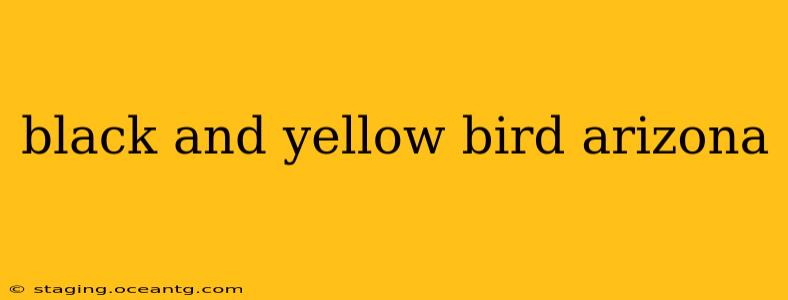Arizona boasts a rich biodiversity, and spotting a black and yellow bird is a common yet exciting experience for bird enthusiasts and casual observers alike. Several species fit this description, making identification crucial. This guide will help you pinpoint the specific avian visitor gracing your Arizona landscape. We'll explore the most likely candidates and address common questions surrounding these striking birds.
What Black and Yellow Birds Live in Arizona?
Several species of black and yellow birds call Arizona home, or are frequent visitors during migration. The most common suspects include:
-
Northern Flicker: This woodpecker is easily recognized by its black barring, spotted breast, and a prominent yellow undertail. Males have a red crescent on the nape of their neck. They're widespread across Arizona.
-
Black-chinned Hummingbird: While not entirely black and yellow, the black chin and yellow-green throat of the male are striking features. These tiny, energetic birds are frequent visitors to gardens and feeders across the state.
-
Yellow-rumped Warbler (Myrtle Warbler): This warbler exhibits a yellow rump patch (hence the name), olive-green back, and black streaks across its breast. They're common during migration and wintering periods.
-
Baltimore Oriole: A vibrant visitor, the male Baltimore Oriole showcases a striking black and orange (which can appear yellow from a distance) coloration. They are less common than the others listed.
What is the most common black and yellow bird in Arizona?
The Northern Flicker is likely the most commonly encountered black and yellow bird across Arizona. Their wide distribution and relatively large size make them easy to spot in various habitats, from woodlands to urban areas.
What small black and yellow bird is in Arizona?
The Black-chinned Hummingbird is the most likely candidate for a small, black and yellow bird in Arizona. Its size is significantly smaller than the Northern Flicker, and its quick, darting movements are characteristic.
Are there any poisonous black and yellow birds in Arizona?
No, there are no poisonous birds in Arizona. The black and yellow coloration is often a warning signal in other parts of the world (think poison dart frogs), but Arizona birds with this coloration are not poisonous or venomous.
Where can I see black and yellow birds in Arizona?
Black and yellow birds in Arizona are found in a variety of habitats. The Northern Flicker frequents wooded areas, parks, and even suburban backyards. Hummingbirds are common near flowering plants and hummingbird feeders. Warblers often inhabit riparian areas, woodlands and forests during migration. The best places to spot them depend on the specific species and time of year.
What is the difference between the male and female black and yellow birds in Arizona?
Sexual dimorphism (differences between males and females) varies significantly among species. For instance, the Northern Flicker male displays a red crescent on the nape, while females lack this feature. Black-chinned hummingbirds also show distinct differences; male's have that characteristic black throat. Yellow-rumped warblers show less distinct differences between sexes. It's essential to consult field guides or online resources with detailed images for accurate identification based on the specific species you're observing.
How can I attract black and yellow birds to my Arizona yard?
Attract these birds to your backyard by planting native flowering plants to attract hummingbirds and insects. For flickers, providing suet feeders is a good idea. Maintaining a natural habitat with trees and shrubs will encourage a more diverse bird population, including those with black and yellow plumage.
This guide aims to provide a comprehensive overview of black and yellow birds commonly found in Arizona. Remember to utilize bird identification apps and field guides for more detailed information and precise species identification. Happy birding!
